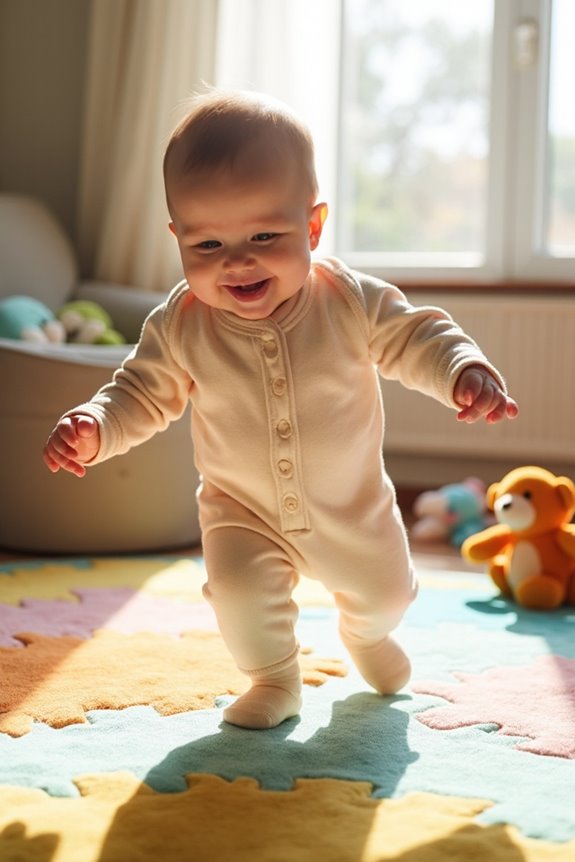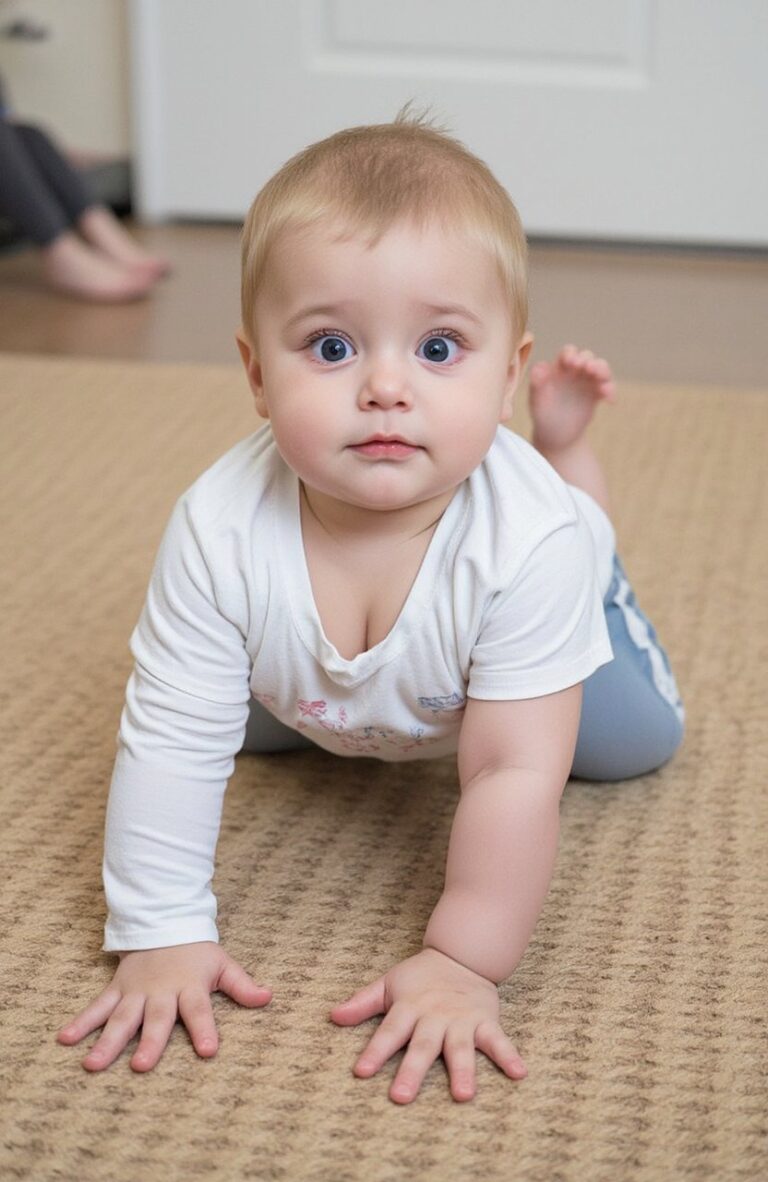Most babies take their first steps around 12 months, but the timing can vary widely from 9 to 18 months. Each child develops at their own pace, influenced by factors like genetics and environment. Before walking, they typically pull up to stand, cruise along furniture, and stand unassisted. About 75% of children take their first steps by 14 months. If you’re curious about the stages that lead to walking, we can share more insights on this journey.
Key Takeaways
- Most babies take their first steps around 12 months, with a typical range of 9 to 18 months.
- Key signs of walking readiness include pulling up to stand, cruising along furniture, and standing unassisted.
- About 25% of children walk by 12 months; this increases to 75% by 14 months.
- The average age for independent walking is approximately 13.1 months, with most children crawling beforehand.
- Environmental factors and active play opportunities can influence the timing of walking milestones.
Typical Ages for Walking
When it comes to walking, most babies take their first steps around 12 months, but there’s a wide range of what’s considered normal. While some little ones might surprise us by walking as early as 9 months, others might take their time and start closer to 17 or even 18 months. Each child develops at their own pace, and that’s perfectly okay.
Key signs of walking readiness include:
- Pulling up to stand
- Cruising along furniture
- Standing unassisted
We should remember that cultural practices, genetics, and health can all influence walking milestones. By understanding these variations, we can better support our babies on their exciting journey toward independence. It’s all about celebrating each step they take!
Key Milestones Before Walking

As our little ones grow, they’ll pass through several key milestones that pave the way for walking. One of the first signs is pulling up to stand, usually happening between 7 to 10 months. This action not only strengthens their leg muscles but also helps develop essential balancing skills.
Here are some milestones to look out for:
- Balancing on Feet: After pulling up, they’ll start to learn how to balance, an important step toward walking.
- Weight Shifting: As they gain confidence, they’ll practice shifting their weight, crucial for taking those first steps.
- Cruising: Holding onto furniture, they’ll move sideways, refining their coordination and core strength.
These milestones create a solid foundation for independent walking.
Variability in Walking Development
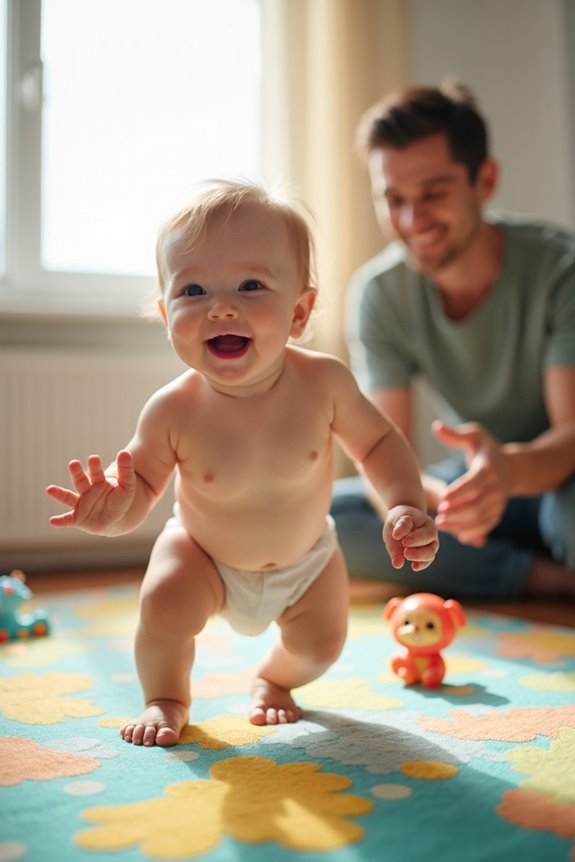
While every baby is unique, we should understand that the age at which infants begin to walk can vary significantly. Most babies typically walk between 8 to 18 months, but several factors contribute to this variability:
- Genetic Influences: About 25% of walking age differences come from genetics.
- Motor Skill Development: Skills like crawling and sitting impact when babies start walking.
- Environmental Factors: The opportunities for active play and movement can accelerate walking patterns.
Some populations, like Bellevue infants, may walk later than others, such as Langone infants. By recognizing these developmental differences, we can appreciate the beautiful range of walking journeys that each baby experiences, making this milestone even more special.
Understanding Progression Stages
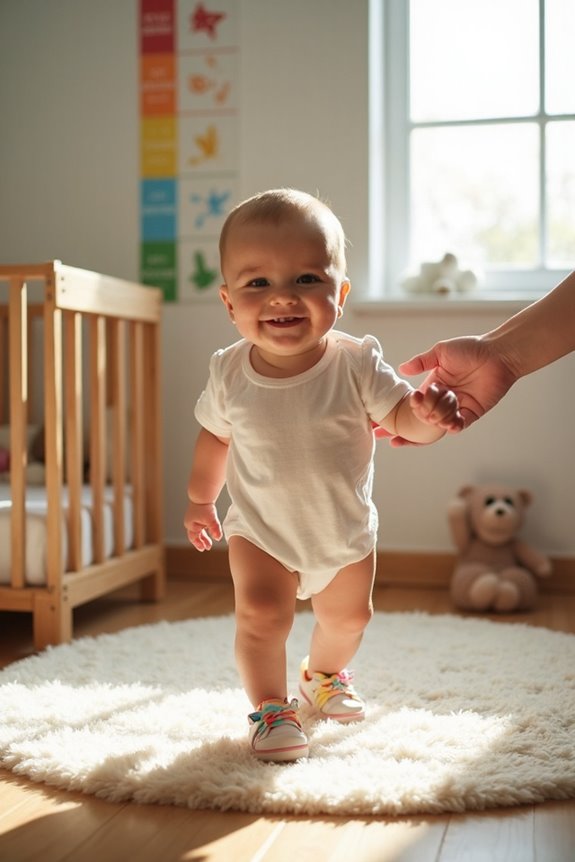
Understanding the stages of progression in walking development can be fascinating and enlightening for parents and caregivers. As our little ones grow, we witness key milestones that signal their physical development:
- Pulling Up to Stand: This usually starts between 7 and 10 months, marking the beginning of leg muscle strength.
- Cruising: Around 9 to 13 months, babies begin walking while holding onto furniture, enhancing their balance.
- Standing Unassisted: This often follows pulling up and cruising, typically between 9 and 12 months.
Encouraging these progression stages involves creating a safe environment, modeling behaviors, and offering support. Each stage builds confidence and coordination, essential for independent walking. By celebrating these small victories, we’re nurturing their growth and helping them thrive on this journey toward mobility.
Relevant Statistical Data on Walking
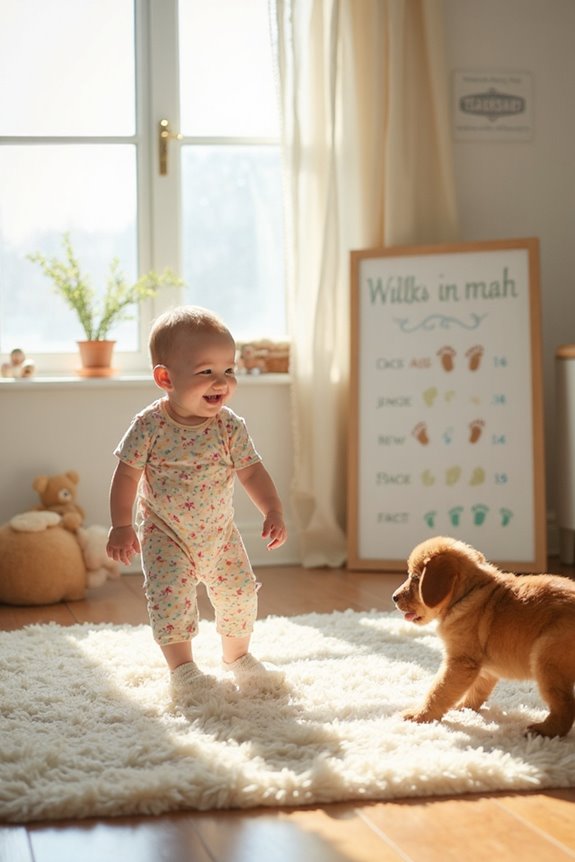
Statistically, around 25% of children take their first steps by 12 months, and this number rises to 75% by 14 months. It’s fascinating to note that the mean age for independent walking is approximately 13.1 months.
Here are some key insights:
- Walking Strategies: Most children (84.5%) crawl before they walk, with those crawling on hands and knees often starting to walk earlier.
- Parental Reporting: Parents tend to provide more consistent reports of walking onset than observational studies.
Understanding these statistics can help us appreciate the variability in walking development. Each child’s journey is unique, and staying attuned to their individual progress is essential. By sharing experiences, we can support one another through this exciting milestone!
Influencing Factors in Walking Development

As we explore the fascinating journey of walking development, we find that numerous factors come into play. Genetic influences play a significant role, accounting for about 25% of the differences in when children take their first steps. With a wide range from 8 to 24 months, each child’s journey is unique.
Environmental impacts are equally vital. Consider these elements:
- Parental encouragement can boost a child’s confidence.
- A safe and accessible space allows for practice.
- Quality interactions with caregivers foster motivation.
When to Seek Pediatric Evaluation
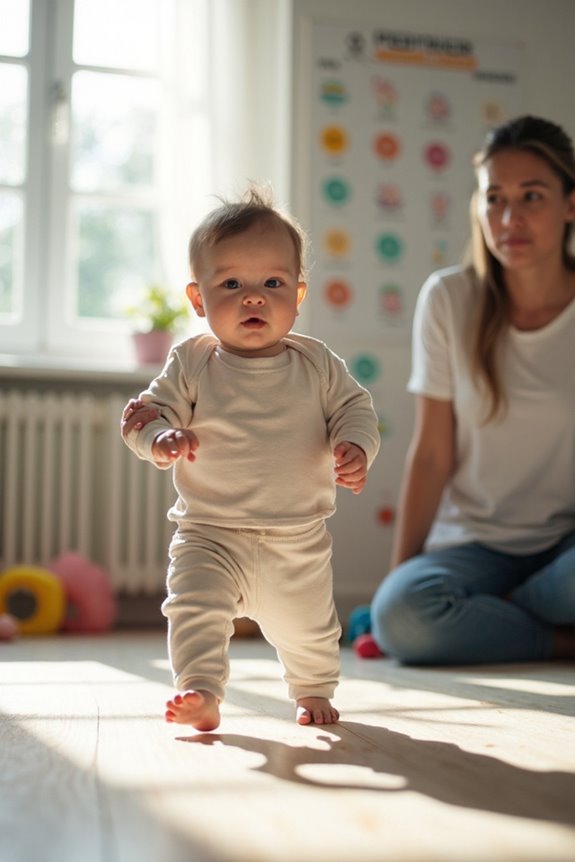
When we think about our little ones and their walking milestones, it’s important to know when to seek a pediatric evaluation. If your child isn’t walking independently by 18 months, it’s time to consider a pediatric assessment. Here are some signs to watch for:
- Persistent toe walking or abnormal gait patterns may indicate developmental concerns.
- Lack of progress in sitting or standing can be a red flag.
- Speech delays or a history of severe jaundice are also worth discussing with your pediatrician.
Frequently Asked Questions
What Are Common Signs My Baby Is Ready to Walk?
As we observe our little ones, signs of walking readiness include pulling up, standing alone, and cruising along furniture. These developmental milestones show their growing strength and confidence, inviting us to celebrate each step forward together.
Can Early Walking Affect My Child’s Future Physical Development?
We’ve seen kids take their first steps like tiny explorers. Early walking can have some long-term effects on motor skills, but every child’s journey is unique, and there’s no rush—let’s embrace their pace together.
How Can I Encourage My Baby to Start Walking?
To encourage our baby to start walking, we can use effective walking techniques while ensuring safety measures. Let’s create a safe space, use engaging toys, and offer praise, making every step a joyful experience together.
Are There Toys That Help Promote Walking Skills?
We often wonder about the best walking toys for our little ones. These toys can really help with balance development, making their first steps feel more secure and exciting. Let’s explore together and find the right ones!
What Should I Do if My Baby Prefers Crawling Over Walking?
If our baby prefers crawling, let’s embrace those crawling benefits while gently encouraging walking confidence. We can create safe spaces for practice, celebrate small victories, and remember that each child’s journey unfolds at their own pace.

